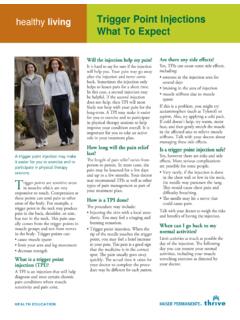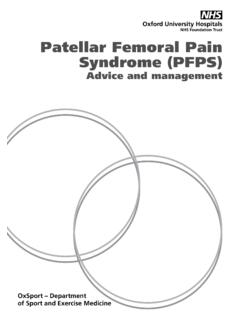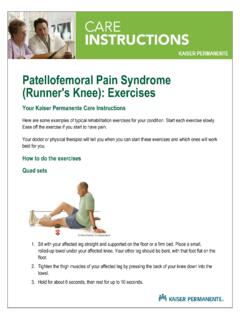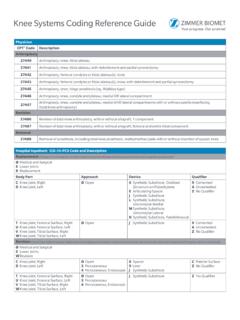Transcription of Patellofemoral Syndrome Tips and Exercises
1 Physical Therapy Patello- femoral Syndrome (PFS) is an irritation under the knee cap (Patella) and the surrounding tissues due to increased compression. There can be pain around or under the kneecap and sometimes in the back of the knee. Painful activities may include: Running or Jumping Walking when it is flared up Sitting Going up or down stairs Squatting or kneeling Driving Walking on hills or ramps What contributes to PFS? Tight hip or knee muscles Weak hip or knee muscles Flat feet A knee that collapses inward while standing, walking or playing sports Repetitive or excessive amounts of activity Improper squatting mechanics Poor jumping mechanics What can you do? Use an ice pack: Put an ice pack on your knee for 10 -15 minutes, 3-4 times per day. Make sure you ice after activity. Wear supportive shoes: Good arch support and supportive shoes decrease pain with activities by achieving good alignment. Avoid non-supportive shoes like, flip flops, sandals and high heels.
2 Modify your activities: Limit repetitive or excessive amounts of activities that increase pain. Compressive activities like squatting, stairs, running, and jumping put the most pressure on your knees. Replace these activities with less compressive activities such as biking, swimming, water aerobics and the elliptical trainer. Use a pad under your knees when kneeling. Change your leg position often when sitting. Take frequent breaks. Stretch tight muscles. The best time to stretch is after you warm-up. Quadriceps Front of thigh stretch Place your foot on a chair behind you. Gently tighten your buttocks and feel the stretch on the front of the thigh. Hold 30 -60 seconds, 3-4 times per day. IT band stretch Stand with the leg you want to stretch crossed behind the other. Hold onto a wall or chair on the side you want to stretch. Lean your hips towards the chair or wall until you feel a stretch on the side of your hip. Hold 30-60 seconds, repeat 3-4 times per day.
3 Patello - femoral Syndrome 012701-006 (REV. 7-11)Physical Therapy Strengthen muscles to improve alignment. Quadriceps set: Place a small towel roll under your knee. Straighten your knee by tightening your thigh muscles. Press the back of your knee into the towel and hold for 5-10 seconds. Repeat 10-20 times, 3-4 times per day. This may also be done sitting. Straight leg raising: Lie on your back with your affected leg straight and your other leg bent. Tighten your thigh muscles then lift your leg no higher than the other knee. Keep your knee fully straight while you lift and lower your leg. Ke ep your thigh muscles tight while you lower your leg. Repeat 10-20 times, 3-4 times per day. Bridging: Lie on your back with knees bent and feet flat on the floor. Gently tighten your stomach and buttock muscles. Lift your hips 3-5 inches from the floor without arching your back. Hold for 5-10 seconds, and then slowly lower your hips to the floor. Repeat 20-30 times.
4 Consult with your physical therapist or doctor if you experience an increase in your symptoms with recommended Exercises , or if you develop new symptoms of numbness, tingling, or a spread of the pain. This information is not intended to diagnose health problems or to take the place of medical advice or care you receive from your physician or other health care professional. If you have persistent health problems, or if you have additional questions, please consult with your doctor. If you have questions or need more information about your medication, please speak to your pharmacist. Kaiser Permanente does not endorse the medications or products mentioned. Any trade names listed are for easy identification only. Top leg lifts:Lie on your unaffected side with your top leg straight. Bend your bottom leg to help keep you balanced. Gently tighten your abdominals to protect your back. Slowly lift your top leg up towards the ceiling 6-8 inches. Keep your knee pointing forward and your ankle in line with your trunk.
5 Do not roll your body or pelvis backwards. Repeat 20-30 times. Clam: Lie on your side with both knees bent and positioned in front of you. Gently tighten your abdominal muscles to protect your back. Slowly raise your top knee up and outward like a clam opening while keeping your feet together. Keep your buttock muscles tight throughout the exercise. Hold for 5 seconds then slowly lower your knee back to the starting position. Do not roll your body or pelvis backward. Repeat 20-30 times. Wall squat: Stand with your back to the wall and your feet about 12 inches away. Perform a small squat, making sure your knees stay over your ankles. Hold the position for 5-10 seconds. Return to standing and repeat 10-20 times. 012701-006 (REV. 7-11) REVERSE


















